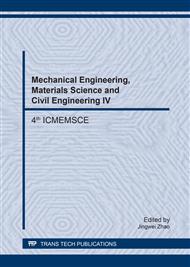[1]
J. Brübach, C. Pflitsch, A. Dreizler, B. Atakan, On surface temperature measurements with thermographic phosphors: A review, Prog. Energ. Combust. 39 (2013) 37-60.
DOI: 10.1016/j.pecs.2012.06.001
Google Scholar
[2]
F. Vetrone, R. Naccache, A. Zamarrón, A. J. de la Fuente, F. Sanz-Rodríguez, L. M. Maestro, E. M. Rodriguez, D. Jaque, J. G. Solé, J. A. Capobianco, Temperature sensing using fluorescent nanothermometers, ACS Nano, 4 (2010) 3254-3258.
DOI: 10.1021/nn100244a
Google Scholar
[3]
L. H. Fischer, G. S. Harms, O. S. Wolfbeis, Upconverting nanoparticles for nanoscale thermometry, Angew. Chem. Int. Ed. 50 (2011) 4546-4551.
DOI: 10.1002/anie.201006835
Google Scholar
[4]
S. A. Wade, S. F. Collins, G. W. Baxter, Fluorescence intensity ratio technique for optical fiber point temperature sensing, J. Appl. Phys. 94 (2003) 4743-4756.
DOI: 10.1063/1.1606526
Google Scholar
[5]
S. A. Wade, S. F. Collins, G. W. Baxter, Fluorescence intensity ration technique for optical fiber point temperature sensing, Appl. Phys. Rev. 94 (2003) 4743-4757.
DOI: 10.1063/1.1606526
Google Scholar
[6]
S. Zheng, W. Chen, D. Tan, J. Zhou, Q. Guo, W. Jiang, C. Xu, X. Liu, J. Qiu, Lanthanide-doped NaGdF4 core-shell nano-particles for non-contact self-referencing temperature sensors, Nanoscale, 6 (2014) 5675-5679.
DOI: 10.1039/c4nr00432a
Google Scholar
[7]
X. Wang, O. S. Wolfbeis, R. J. Meier, Luminescent probes and sensors for temperature, Chem. Soc. Rev. 42 (2013) 7834.
DOI: 10.1039/c3cs60102a
Google Scholar
[8]
D. Chen, S. Liu, Z. Wan, Y. Chen, A highly sensitive upconverting nano-glass-ceramic-based optical thermometer, J. Alloy. Compd. 672 (2016) 380-385.
DOI: 10.1016/j.jallcom.2016.02.138
Google Scholar
[9]
B. S. Cao, Y. Y. He, Z. Q. Feng, Y. S. Li, B. Dong, Optical temperature sensing behavior of enhanced green upconversion emissions from Er-Mo: Yb2Ti2O7 nanophosphor, Sensor Actuat. B 159 (2011) 8-11.
DOI: 10.1016/j.snb.2011.05.018
Google Scholar
[10]
J. Cai, X. Wei, F. Hu, Z. Cao, Y. Chen, C. Duan, M. Yin, Up-conversion luminescence and optical thermometry properties of transparent glass ceramics containing CaF2: Yb3+/Er3+ nanocrystals, Ceram. Int. 2016 http: /dx. doi. org/10. 1016/j. ceramint. 2016. 06. 002.
DOI: 10.1016/j.ceramint.2016.06.002
Google Scholar
[11]
F. Huang, Y. Gao, J. Zhou, J. Xua, Y. Wang, Yb3+/Er3+ co-doped CaMoO4: a promising green upconversion phosphor for optical temperature sensing, J. Alloy. Compd. 639 (2015) 325-329.
DOI: 10.1016/j.jallcom.2015.02.228
Google Scholar
[12]
Y. Zhou, B. Yan, Lanthanides post-functionalized nanocrystalline metal-organic frameworks for tunable white-light emission and orthogonal multi-readout thermometry, Nanoscale, 7 (2015) 4063-4069.
DOI: 10.1039/c4nr06873d
Google Scholar
[13]
X. Lian, D. Zhao, Y. Cui, G. Qian, A near infrared luminescent metal-organic frameworks for temperature sensing in physiological range, Chem. Comm. 2016, DOI: 10. 1039/C5CC07532G.
Google Scholar
[14]
D. Zhao, J. Zhang, D. Yue, X. Lian, Y. Cui, Y. Yang, G. Qian, A highly sensitive near-infrared luminescent metal-organic framework thermometer in physiological range, Chem. Comm. 2016, DOI: 10. 10139/C6CC02471H.
DOI: 10.1039/c6cc02471h
Google Scholar
[15]
Y. Su, L. Li. G. Li, Synthesis and optimum luminescence of CaWO4-based red phosphors with codoping of Eu3+ and Na+, Chem. Mater. 20 (2008) 6060-6067.
DOI: 10.1021/cm8014435
Google Scholar
[16]
X. Cheng, K. Yang, J. Wang, L. Yang, X. Cheng, Up-converted luminescence and optical temperature sensing behavior of Yb3+/Er3+ codoped CaWO4 material, Opt. Mat. 58 (2016) 449-453.
DOI: 10.1016/j.optmat.2016.06.029
Google Scholar
[17]
W. Xu, H. Zhao H, Y. Li, L. Zheng, Z. Zhang, Optical temperature sensing through the upconversion luminescence from Ho3+/Yb3+ codoped CaWO4, Sensor Actuat. B, 188 (2013) 1096-1100.
DOI: 10.1016/j.snb.2013.07.094
Google Scholar
[18]
A. Golubović, R. Gajić, Z. Dohčević-Mitrović, S. Nikolić, Nd induced changes in IR spectra of CaWO4 single crystals, J. Alloy. Compd. 415 (2006) 16-22.
DOI: 10.1016/j.jallcom.2005.07.056
Google Scholar


